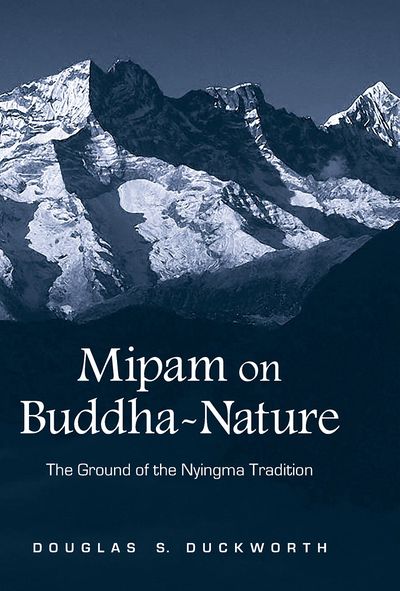- Prefaceix
- Introductionxi
- Presence and Absencexii
- Historical Surveyxvii
- Monastic Education and the Nonsectarian Movementxx
- Life and Works of Mipamxxiii
- Summary of Contentsxxviii
- The End of the Beginningxxxii
- Chapter 1. Buddha-Nature and the Unity of the Two Truths1
- Introduction1
- Mipam’s Synthesis4
- Two Truths6
- Buddha-Nature as the Unity of Appearance and Emptiness13
- Buddha-Nature as the Definitive Meaning20
- Conclusion26
- Chapter 2. Middle Way of Prāsaṅgika and Yogācāra27
- Chapter 3. The Present Absence55
- Chapter 4. Buddha-Nature and the Ground of the Great Perfection93
- Introduction93
- Distinguishing the Views on Buddha-Nature94
- Buddha-Nature as Heritage, Buddha-Nature as the Ground99
- Appearance and Reality107
- Conclusion114
- Chapter 5. The Indivisible Ground and Fruition117
- Introduction117
- Establishing Buddha-Nature: The Immanent Buddha118
- Establishing Appearances as Divine124
- Buddha-Nature and a Difference Between Sūtra and Mantra131
- Conclusion139
- Conclusion141
- Translations of Primary Texts145
- Appendix 1. Lion’s Roar: Exposition of Buddha-Nature147
- Stating Other Traditions149
- Presenting Our Authentic Tradition153
- The Meaning of the First Verse "Because the body of the perfect
Buddha is radiant"153 - The Meaning of the Second Verse "Because thusness is indivisible"159
- The Meaning of the Third Verse "Because of possessing heritage"162
- The Meaning of the First Verse "Because the body of the perfect
- Refuting the View that [the Basic Element] Is Truly Established and Not Empty167
- Refuting the View that [the Basic Element] Is a Void Emptiness168
- Refuting the Apprehension of [the Basic Element] as Impermanent and Conditioned170
- Appendix 2. Notes on the Essential Points of [Mipam’s] Exposition
[of Buddha-Nature]181
- Appendix 1. Lion’s Roar: Exposition of Buddha-Nature147
- Notes191
- Bibliography265
- Index281
No edit summary |
No edit summary |
||
| (2 intermediate revisions by the same user not shown) | |||
| Line 1: | Line 1: | ||
{{Book | {{Book | ||
|BookPerson={{Book-person | |BookPerson={{Book-person | ||
|PersonPage=Mi pham rgya mtsho | |PersonPage=Mi pham rgya mtsho | ||
| Line 58: | Line 57: | ||
*** {{i|Stating Other Traditions|149}} | *** {{i|Stating Other Traditions|149}} | ||
*** {{i|Presenting Our Authentic Tradition|153}} | *** {{i|Presenting Our Authentic Tradition|153}} | ||
**** {{i|The Meaning of the First Verse "Because the body of the perfect Buddha is radiant"|153}} | **** {{i|The Meaning of the First Verse "Because the body of the perfect<br>Buddha is radiant"|153}} | ||
**** {{i|The Meaning of the Second Verse "Because thusness is indivisible"|159}} | **** {{i|The Meaning of the Second Verse "Because thusness is indivisible"|159}} | ||
**** {{i|The Meaning of the Third Verse "Because of possessing heritage"|162}} | **** {{i|The Meaning of the Third Verse "Because of possessing heritage"|162}} | ||
| Line 64: | Line 63: | ||
*** {{i|Refuting the View that [the Basic Element] Is a Void Emptiness|168}} | *** {{i|Refuting the View that [the Basic Element] Is a Void Emptiness|168}} | ||
*** {{i|Refuting the Apprehension of [the Basic Element] as Impermanent and Conditioned|170}} | *** {{i|Refuting the Apprehension of [the Basic Element] as Impermanent and Conditioned|170}} | ||
** {{i|Appendix 2. ''Notes on the Essential Points of [Mipam’s] Exposition [of Buddha-Nature]''|181}} | ** {{i|Appendix 2. ''Notes on the Essential Points of [Mipam’s] Exposition<br>[of Buddha-Nature]''|181}} | ||
* {{i|Notes|191}} | * {{i|Notes|191}} | ||
* {{i|Bibliography|265}} | * {{i|Bibliography|265}} | ||
* {{i|Index|281}} | * {{i|Index|281}} | ||
|QuotesTabContent={{GetBookQuotes}} | |QuotesTabContent={{GetBookQuotes}} | ||
|PublisherLogo=File:SUNY Press logo.jpg | |PublisherLogo=File:SUNY Press logo.jpg | ||
|StopPersonRedirects=No | |||
|AddRelatedTab=No | |||
|BookParentPage=Secondary Sources | |||
|AddQuotesTab=Yes | |AddQuotesTab=Yes | ||
}} | }} | ||
Latest revision as of 11:17, 30 June 2023
A comprehensive overview of Tibetan Buddhist thinker Mipam’s work on emptiness and Buddha-nature.
Mipam ( 'ju mi pham rgya mtsho, 1846–1912) is one of the most prolific thinkers in the history of Tibet and is a key figure in the Nyingma tradition of Buddhism. His works continue to be widely studied in the Tibetan cultural region and beyond. This book provides an in-depth account of Mipam’s view, drawing on a wide range of his works and offering several new translations. Douglas S. Duckworth shows how a dialectic of presence and absence permeates Mipam’s writings on the Middle Way and Buddha-nature.
Arguably the most important doctrine in Buddhism, Buddha-nature is, for Mipam, equivalent to the true meaning of emptiness; it is the ground of all and the common ground shared by sentient beings and Buddhas. This ground is the foundation of the path and inseparable from the goal of Buddhahood. Duckworth probes deeply into Mipam’s writings on Buddha-nature to illuminate its central place in a dynamic Buddhist philosophy. (Source: SUNY Press)
| Citation | Duckworth, Douglas S. Mipam on Buddha-Nature: The Ground of the Nyingma Tradition. Albany: State University of New York Press, 2008. http://promienie.net/images/dharma/books/mipham_buddha-nature.pdf. |
|---|---|
- Mi pham rgya mtsho. bde gshegs snying po'i stong thun chen mo seng+ge'i nga ro. Bylakuppe: Ngagyur Nyingma Institute, 2002.

- Mi pham rgya mtsho. bde gshegs snying po'i stong thun chen mo seng+ge'i nga ro. In bka' ma shin tu rgyas pa (kaH thog), Vol. 49: 369 - 434. Chengdu: kaH thog mkhan po 'jam dbyangs, [1999].

- Alternate Online version: RYwiki - Online Translation available from Gyurme Avertin: Mipham Rinpoche, Lion's Roar: Buddha Nature in a Nutshell
Existent entities arise in dependence upon something else; they are dependent arisings. "Nonentities like space are also dependent because they are imputed in dependence upon entities. This interdependence does not make phenomena go away, but is the necessary condition for their arising. Also, this is why phenomena lack any truly established individual essences.
~ in Mipam on Buddha-Nature, page(s) 8


